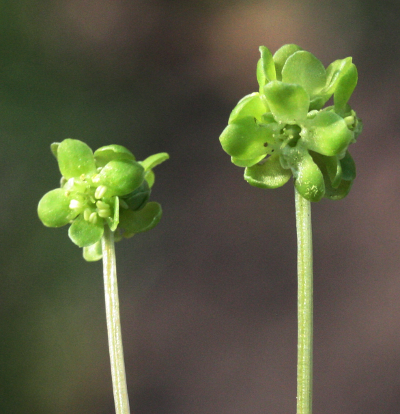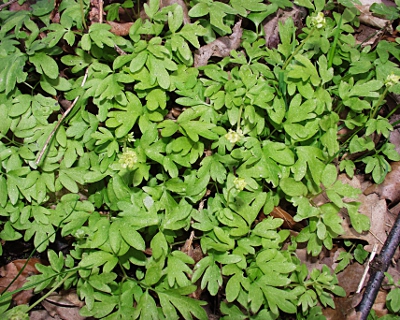Adoxa |

Inflorescences of Adoxa moschatellina

The strongly divided leaves of the muschatel are more striking as the yellow-green inflorescences
Therefore, one could translate Adoxa with "lackluster". It is probably an allusion to the fact, that the plant is so inconspicuous and little known. It was named first by Linnaeus in his work Species plantarum 1753.
"Moschatel" or "muskroot" the plants are be called, because the crushed leaves slightly smell musky, especially in rainy weather and during the withering. The names „five-faced bishop" or "town hall clock" refers to the cubic inflorescences.
Muskroots that contain about 3–8 different species have trifoliate or digitate leaves and a cube-shaped inflorescence. The 4–5 green petals are united at the base and form a very short tube, the calyx has 2–3 lobes. The 4–5 stamens are deeply divided, so they they look like 8 or 10. The 3–5 styles are short and united at the base. The ovary shows 3–5 locules. Out of this develops a stone fruit that contain 3–5 seeds.
| Floral formula: |
Although the musk herb often found in large populations, it is easily overlooked. This is partly attributable to the fact that the plants are usually only around 10 cm high and often grow in dark, shady places. In addition, the flowers are very inconspicuous.
The petals are pale or yellowish green and hardly to distinguish from the leaves by color. In addition, the plants wither after flowering very quickly. But if they are discovered in early spring, so fascinated those interested the strange inflorescence. It's typically cube-shaped with a 4-fold flower on the top and four 5-fold lateral flowers. Sometimes flower heads occur with 3–7 flowers.
Historical publications
At Johann Bauhin (1541–1612) Adoxa moschatellina was named "Moschatellina foliis fumariae bulbosae" which means "Moschatel with leaves like the spring fumewort (Corydalis solida).
Meaning of the species name
- moschatellina: lat. moschatus = "musky smelling", moschatellina = double diminutive of moschata = "very weak musk-smelling"
Interesting notes
-
In ancient times, the dried leaves of muskroot were laid between the laundry for perfuming.